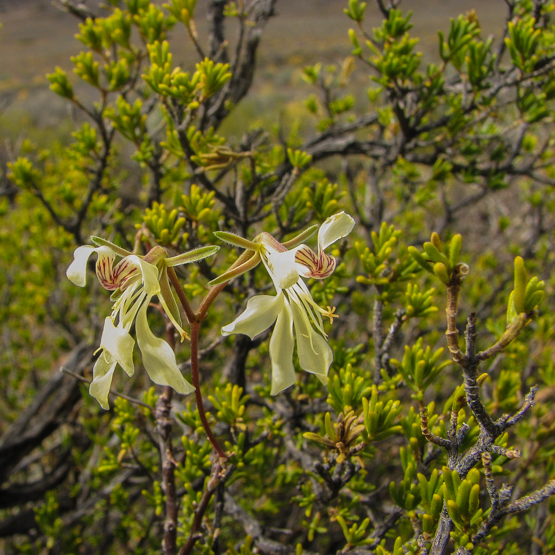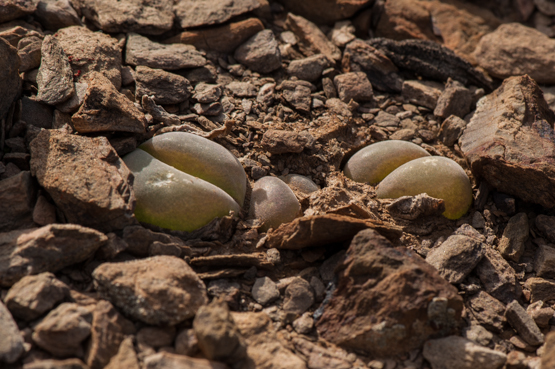The great Linnaeus himself described this species way back in 1760. The adjective muscosus means moss-like, which is certainly an apt name for some of the many guises in which this species comes.
In var. muscosa the branches are usually 20-40 cm long (sometimes up to 80 cm) and upright, creeping or scrambling. An old synonym for it is Crassula lycopodioides, referring to Lycopodium or clubmoss. This variety is found from southern Namibia to South Africa’s South coast, but is especially widespread in Namaqualand and the Great Karoo and neighbouring areas. Even within this one variety (there are four in total) one comes across a great number of different forms. In the wild the leaves are generally greyish green to brown; in cultivation one also finds other colours.
The plants often grow in very dry spots. The same thin and densely leaved branches that make them look so delicate, seem to be rather effective in condensing dew and fog and channeling this moisture to their roots.
Tag: Little Karoo
Crassula capitella subsp. thyrsiflora
H. R. Toelken in his “Revision of the genus Crassula in southern Africa” calls this the most complex subspecies found in C. capitella, which in turn he refers to as a complex species.
The subspecies is widely distributed in the Eastern and Western Cape provinces, Limpopo and southeastern Namibia.
The white or pink flowers are borne in groups along an elongated inflorescence (up to 40 cm tall) and appear between November and March.
In cultivation one normally sees the form shown in the first four pictures.
The photo below shows plants as they are found in and around the Anysberg Nature reserve. They have beautifully marked leaves which are much shorter then one would expect in subsp. thyrsiflora.
As the reserve is on the western border of the distribution area of subsp. capitella, they may belong there, but I will have to see the flowers before being able to properly identify them.
Pelargonium crithmifolium (3)
Pelargonium crithmifolium (2)
In the preceding post I mentioned the persisting inflorescences that are so characteristic of this species. When you look back at that post you will notice that even young plants produce them.
One cannot help but wonder what purpose these outgrowths serve apart from the obvious one: supporting the flowers and fruits (which could be done with a far less complicated and heavy structure). We have to bear in mind that these plants live in difficult circumstances and cannot afford unnecessary extravagances. In other words, there must be a proper return on investment and the best return would be one that helps the plants to survive.
To my mind, the persisting inflorescence has three functions:
— It keeps browsing predators away.
— It helps shade the plant and thereby lower the temperature.
— The intricate structure of branches diminishes the speed of the usually hot and desiccating wind.
It is interesting that these functions have their strongest influence at the place where they are most helpful: the growing tips of the stems, with their soft and tender young leaves.
More pictures to follow.
Pelargonium crithmifolium (1)
With its thick stems and a height of up to 1 meter, this species is one of the giants among the succulent Pelargoniums. Only P. carnosum is occasionally taller (up to 1.2 m). The species is characterized by its large, much branched inflorescences which become hard and spine-like and will persist for at least a year. The flowers appear from March to November.
The plants occur sporadically from southern Namibia to the western Great Karoo and the Little Karoo on dry, hot flats and slopes, often in crevices of rocky outcrops.
Senecio acaulis (2)
Senecio (Curio) acaulis. Part 1
These plants may be up to 30 cm tall but are usually much lower.
The leaves are up to 10 cm long and cylindrical (in the dry season they become flattened). Apparently they are tasty to some animals, as one often sees them with the upper half chewed off.
The flowers appear in Oct. Nov. and are large and showy (up to over 2 cm in diameter).
The species occurs on rocky outcrops from the Ceres Karoo to the Kouga Mts.
Pelargonium karooicum
“This species has little horticultural appeal, always looking as if it were more than half dead.”
How about that for a recommendation? It comes from “Pelargoniums of Southern Africa” vol. 3. and yes, if you have space for just one more Pelargonium in your collection, this will not be high on your wants list.
But if you are in the field somewhere between January and April, when very little else is flowering, the white, pale yellow or pink flowers sticking out from a shrub, are a welcome sight.
The plants are shrublets of up to 40 cm tall. with thin, slightly woody stems and parsley-like, somewhat succulent leaves. The species is widely distributed from the vicinity of Kleinzee in Namaqualand to Oudtshoorn in the eastern Little Karoo. This is part of the winter rainfall area, with very hot summers and cool, but mainly frost free winters. Without flowers the plants are difficult to find, as they are always growing within other shrubs.
Gibbaeum nebrownii (2)
Gibbaeum nebrownii (1)
It has taken me a couple of years to be at the right spot at the right time to photograph this species in flower. I knew of only one small locality, some 130 kms from where I lived and the few times I went there they were not in flower. Nowadays I live much nearer, but the main thing is that I found out that the plants flower a few months earlier than almost all other Gibbaeums (late April and early May). Anyway, yesterday I went there with two friends and lo and behold: there they were, in full bloom.
“The Gibbaeum Handbook” by G. C. Nel (1953), gives the following information:
The shale hillocks, on which it seems to thrive best, consist of laminated shales and are entirely devoid, at times, of any other vegetation. They are quite bare and G. nebrownii is embedded in the soil and only the top surface is exposed. During the hot summer months, it is withdrawn into the soil and one only sees a brown membrane, the remainder of the old leaves, and is, consequently, very difficult to find. It resembles a Lithops or an Ophthalmophyllum in this respect. It is squeezed into the crevices between the slate layers”.
The species is only found sporadically in the western part of the Little Karoo.
The first two pictures were taken 30 June 2013, the others 4 May 2014












































